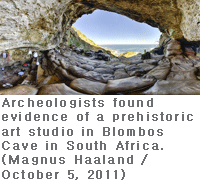 Artifacts indicate a 100,000-year-old art studio
Artifacts indicate a 100,000-year-old art studioIn South Africa, abalone shells covered with pigment and tools for making paints are found in a cave, suggesting humans began thinking symbolically much earlier than previously recognized.
October 14, 2011
In a tiny South African cave, archaeologists have unearthed a 100,000-year-old art studio that contains tools for mixing powder from red and yellow rocks with animal fat and marrow to make vibrant paints as well as abalone shells full of dried-out red pigment, the oldest paint containers ever found.
The discovery, described in Friday's edition of the journal Science, suggests that humans may have been thinking symbolically — more like modern-day humans think — much earlier than previously recognized, experts said. Symbolic thinking could have been a key evolutionary step in the development of other quintessentially human abilities, such as language, art and complex ritual.
The artifacts were uncovered at a well-studied site called the Blombos Cave, which sits by the edge of the Indian Ocean about 180 miles east of Cape Town. The two shells, lying about 6 inches from each other, had a red residue from a soft, grindable stone known as ochre. Ochre is rich in iron compounds that usually give it red or yellow hues, and it is known to have been used in ancient paints. A residual stain line in one of the shells indicated that the mixture had at one time been wet, rather like the brown ring left around the edge of a coffee cup that's been sitting out for too long.
Previous finds had established that early humans made paint to adorn walls and decorate artifacts. But the suite of intact tools and ingredients found in the studio was a rare find that suggested a degree of planning and a basic knowledge of chemistry.
"In general we find pigment," said study coauthor Francesco d'Errico, an archaeologist at the University of Bordeaux in France. "But you never find the container with the residue. We were able to study microscopically all the elements in the recipe."
Along with ground-up red ochre, the mixtures contained charcoal and crushed spongy bones that were probably once rich in fat and marrow. The team also found rock fragments from the grinding stones that were used to make the mixture. One of the stones had remnants of a yellow pigment, perhaps from a previous batch of paint, that was not present in the reddish batches from the abalone shells.
By measuring the damage to quartz sediments caused by radioactive isotopes in the soil around the ochre containers, researchers were able to calculate that the paint tool kits were about 100,000 years old.
The cave was isolated; researchers found few artifacts associated with constant human activity from the same period when the paints were being mixed. Perhaps only one or two artisans from a nearby community came here to mix their paints, the team speculated.
Modern humans are thought to have evolved around 200,000 years ago, but much of the archaeological evidence of humans painting with ochre goes back only 60,000 years, D'Errico said. Examples of ochre use and other complex behaviors from around 100,000 years ago are few and far between, he said.
But the ability to mix and use paint signals a lot of important behaviors that are key to social and cognitive development, said Alison Brooks, a paleoanthropologist at George Washington University who was not involved in the study. Unlike weapons, utensils or other artifacts, paint has little utilitarian value. Paint could be used to decorate objects, clothing or the body, often to send a social message in an increasingly complex society.
"If you only see the same people in the same face-to-face group you've known your entire life, there's no need to make a statement," she said. And as those groups became larger and people traveled farther from home, "there was a need to demonstrate to somebody — at a considerable distance, before they could shoot you — who you were."
In recent years, many anthropologists have made the case that such ochre mixtures were not used as paints but were mixed with plant resins that were used to bind stone spearheads to wooden shafts, Brooks said. As such, the mixtures were a sign of technological development, but not of cultural and cognitive change.
In this cave, however, the ochre had been mixed not with plant resins but with animal fat and marrow, substances that had no use as adhesives, Brooks said, but were excellent binders to make liquid paint.
"All of this, in my view, boils down to [the idea that] their social horizons were expanding," she said.
 Artifacts indicate a 100,000-year-old art studio
Artifacts indicate a 100,000-year-old art studio